This article originally appeared in Tutu Revue.
Years and years ago, I asked Bill Carter — a demi-caractère dancer with American Ballet Theatre, a flamenco dancer manqué, and one of the most soulful artists I’ve ever known — if his vocation had already been evident in his childhood. “Oh, yes,” he reminisced, “I was always dressing up and waving scarves around.” Since that conversation, having raised a dancing child, who now has a dance-mad little daughter of her own, I’ve met with much evidence that there’s a profound connection, especially in the very young, between dancing and costume.
Like dance, costume is a means of self-expression, which is nearly as essential to human life as air, nourishment, and sleep. Here is a young woman — she signs herself “A Girl Graduate” — writing to a newspaper in 1884: “I should like my dress to be a poem about myself, my persona, the outward and visible presentation of my individuality. And that particular mode and fabric and manner which I should choose might not at all recommend itself to my next-door neighbour. Indeed, I hope it would not. For the loveliest and most human thing about humanity is the infinity of its types and modes of manifestation.”
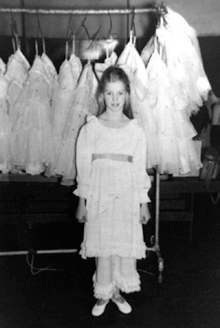
Suzanne Farrell at age 8
While costume — coupled, needless to say, with an artistic sensibility — is a vehicle for realizing one’s unique self, it is equally a powerful means of aspiring or pretending to be other (the secret self, or selves). Another poignantly young writer, Raymond Radiguet, dead at 20 after producing two novels charged with atmosphere, describes in “Le Bal du comte d’Orgel” a backstage visit paid by his exotic protagonists to a troupe of clowns that has captured a sophisticated public’s fancy. “One went to their dressing room as one would to a dancer’s. It was the scene of magnificent ruins, of objects shorn of their original significance that, in the hands of these clowns, took on a much higher meaning.” The theatrical (and spiritual) alchemy of these circus artists is echoed later when the guests preparing for the costume ball of the novel’s title seize the elements of their “disguises” from a jumble of discarded finery: “They saw in these rags the possibility of becoming what they would have wished to be.” Children, of course, are singularly adept at the creative mutability Radiguet celebrates because the young psyche is still pliant, open to myriad identities.
Couple costume with dancing and you’ve added a Dionysian element. Costume envelops the body, but dancing goes further and animates it. A combination of the two allows the expression and metamorphosis of the personality to occur at fever pitch, vastly increasing the potency of the process. All cultures, no matter what their locale or time in human civilization, have known this and used the phenomenon in rites central to their existence. Children seem to know it instinctively.
Both dancing and costume also permit a vision of the self in a state closer to perfection than pedestrian life is likely to allow. They offer opportunities to appear stronger, more compelling, more complex and mysterious — simply more interesting than one is ordinarily. Not least, costume is, like dancing, a way of being beautiful — in one’s own eyes and in the eyes of the audience that is always present, if only by implication, when we indulge in these charmed pursuits. Children, having the innocence and grace to pursue beauty without affectation, are particularly poignant when caught in the act.
The reader will forgive me, I hope, if I take the illustrations for my proposals close to hand. . . .
Not yet four, my granddaughter Lili, willowy and impassioned, dances in her living room wearing a costume for which the word ineffable might have been coined. Its bodice, of ivory crushed velvet, shapes itself to the tender curves of her torso. Its leghorn sleeves are fashioned from a mist of tulle above the elbow, glove-snug velours encasing the arm from elbow to wrist. Its skirt, the hem of which hovers between calf and ankle — this is a sighing Romantic tutu, not one of those short, pert Classical affairs — is confected of layered gauze that floats and clings, a cross between a silken web and drifting clouds. Scattered at random between the multiple skirts are tiny rosebuds. Not a single one is so bold as to appear on the surface, but leads a fugitive, half-hidden life as the child sets the gossamer matrix in motion with her ardent dancing.
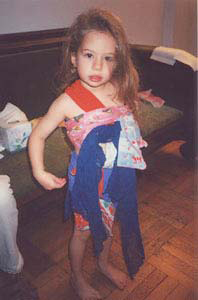
Many a grown woman would be thrilled to be wed in such a dress. Lili herself, despite her extreme youth, is planning to be married — to the person she’d like to spend the rest of her life with (as her mommy has defined the nature of a spouse). Lili’s intended is Auntie Tonya who, as it happens, gave her this garment of dreams.
Meanwhile, Sara, Lili’s very little sister, is determined to be included in the scene. Like many a “subsequent child,” Sara wants to participate in whatever’s going on, whether she understands it or not, whether or not she has acquired the requisite skills. A keen imitator, she has often seen Lili dancing with a collection of scarfs, many of which wrapped the birthday presents of her mother’s childhood. They stand ready to hand in a carryall next to the CD player that provides music for the family’s impromptu ballets. An eminently evocative one — diaphanous, sapphire blue, and randomly studded with minuscule rhinestones — suggests a set designer’s version of a night sky. Another, a kind of lavender cobweb, has done exquisite service wafted around like a haze, a perfume, to indicate the presence of the Lilac Fairy. But Sara’s favorite is a long striped Indian item, rich in robust, contrasting hues and thickly threaded with gold.
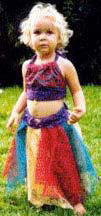
My daughter draws it out, slowly and seductively, from the motley tangle of fabric, asking, “Do you want your costume, Sara?”
“Yes,” the child says decidedly.
“Is it this one?”
“Yes,” says Sara, adding an emphatic nod. She sits on the floor, patient and attentive, nude but for her diaper, as my daughter winds the fabric around her chest, knots it gently, leaving long fringed streamers trailing to either side, and turns on the music.
Not yet in command of walking, Sara remains seated, bouncing avidly on her bottom, waving her plump arms in erratic shapes and rhythms, as Lili dances, my daughter dances, everyone passing through the room dances. Sara’s spangled scarf swirls around her, making her look like an infant escapee from a Bakst design. Who knows what ballets this fledgling conceives? One thing, though, is clear: They cannot be danced in mufti.
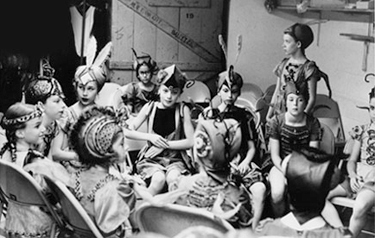
Students of the School of American Ballet, NYC
Perhaps the most poetic costumes in the history of theater are those that fantasy-filled children create themselves for performances of their own devising. Certainly the best professional costumes for “faerie” ballets — those based on “A Midsummer Night’s Dream,” for example — retain the look of a soaring vision given ephemeral substance through improvisation from the materials at hand.
The opposite of such enchanting homemade raiment is the kiddie recital costume, the ghastliness of which, in taste and fabrication, should not be underestimated. By associating only with children who attend dance academies with scruples, you may avoid such exhibitions in real life, where they look not merely tawdry, but tragic — at any rate a travesty of artistic values. Still, evidence of this dance-garb nadir shouts out from the ads that sustain most dance journals: the glitter, the spangles, the coarse nylon net protruding stiffly below sateen bodices, that surreal shade of pink that makes the color of well-masticated bubble gum seem subtle by comparison. A real-life encounter, however, occasionally provides a small miracle: Despite its vulgarity, this sorry finery is transmuted into a metaphor for beauty by the keen belief of the youngsters wearing it.
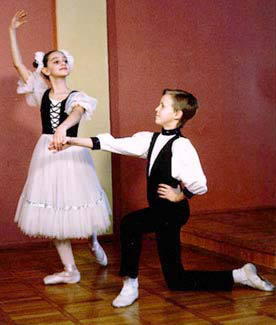
Students of Fantazia, a children’s ballet school,
Dubna, Russia
The costumes worn by committed dance students performing children’s roles with a respectable ballet company are yet another matter. These garments, though they may still convince, even delight, the distant eyes of the audience, are often dilapidated, scarred by repeated repairs, stained with dust, makeup, rosin, and possibly tears. Being expensive, they are kept until they crumble or the ballet they outfit is dropped permanently from the repertory. The turnover in children doing a given role, however, is usually annual; the costume endures while a succession of faceless children outgrow it. The youngster who may be the twentieth or thirtieth body to inhabit one of these battered relics is not necessarily disillusioned. A certain glamour remains operative — as if it had been sewn into the reinforced seams. Recalling the performances of her earliest years at the Maryinsky academy, the legendary ballerina Tamara Karsavina wrote in her memoir “Theatre Street,” “the shabbiest costume was a glorious garment, and had the magic property of charming away all self-consciousness.”
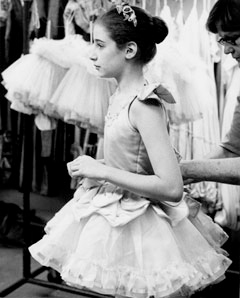
Student of the School of American Ballet, New York City
A seasoned costume can also speak evocatively to the susceptible apprentice of the venerable past of her chosen trade. It’s the custom in some companies to label costumes with the name of their first wearer and to continue to identify them with that name long after the dancer has gone into retirement. My daughter, making her professional stage debut (if you will) as one of the Five Positions that open ABT’s version of Harald Lander’s “Études,” wore a child-scaled tutu labeled “Isabella Fokine.” The Positions are demonstrated by a quintet of female second and third graders. The role, which takes under two minutes to perform, goes like this: tendu into the assigned position, deep plié in same, rise, curtsy, step into sauté arabesque and run off into the wings. My daughter, being the neophyte in the group, was assigned to Second, the position in which you’re least likely to waver in the plié or — don’t even think of it — fall. But to wear the tutu first worn by Isabella Fokine, scion of the Fokine who changed forever the face of ballet — now that was glory!
Here is Jimmy, just five, with a season’s worth of much-desired creative movement cum elementary ballet lessons behind him. At the peak of the summer’s heat, he’s dancing in Lili’s living room. He has the preternatural beauty often seen in Eurasian children and a body so perfectly proportioned it could serve as an anatomical paradigm of what the choosiest ballet academies audition for exhaustively. The arched feet alone are worthy of worship.
The children’s mothers are soul sisters, now regrettably installed on opposite coasts. They’ve gathered for a rare visit with a cluster of other close friends from their student days, accompanied by an assortment of partners and offspring. The youngsters are still churning with energy, but the adults have succumbed to the languor induced by humidity and nostalgia. Jimmy rightly takes the assemblage to be a receptive audience, with luck even a malleable talent pool.
Clad in the cartoon-character briefs little boys affect these days, pink ballet slippers (the store in his town didn’t have black and he couldn’t wait), and a dime-store tiara, he springs about, wielding a plastic magic wand and delivering a simultaneous verbal explication of his antics. Like many a pioneer before him, he is choreographer and star performer at once. The smaller kids, wide-eyed with wonder, along with their bemused parents, are transfigured into aspects of his fantasy.
Wait! There’s another element to Jimmy’s costume, and it may be the key one. It looks like an over-the-edge hostess apron, its lush hues elaborated with shiny embroidery. Its function seems to be that of Prospero’s mantle, the symbol of the wearer’s spellbinding art.
“He’s never without it,” his mother comments, sotto voce.
The moment Jimmy drapes this makeshift cloak over his delicately sculpted shoulders and ties the apron strings to hold it in place, he is whatever he declares himself to be, all others present are who Jimmy declares them to be, and events evolve according to the dictates of Jimmy’s imagination.
Jimmy’s production — a fluid improvisation that has obviously enjoyed previous incarnations — is ambitious, to put it mildly. It has a narrative, fast-moving and fraught at every turn, part pop-culture adventure, part nineteenth-century storybook classics. It has sharply sketched characters, lots of them: good guys (and gals), bad guys (ditto), and supernatural creatures as well as animals. Typical of emergent-choreographer work, it has just about everything. And as all the witnesses are participants too, we players and public, one and the same, are caught up in its immediacy and fervor. Granted, only Jimmy is costumed, but the rest of us, it can safely be claimed, are wrapped in the aura of his fervent illusion.
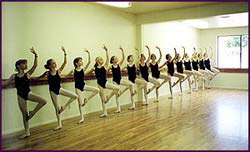
Students of the Children’s Ballet Theatre,
Salt Lake City, Utah
I regret to report that since that vivid August afternoon, Jimmy has retired from dancing. By the time he turned seven, he could no longer bear being the lone boy in his ballet class. But surely other children destined to dance — still mere toddlers, babes-in-arms, or as yet unborn — children whose numbers are legion, will inherit his pink slippers (now grayed with use), his tiara, his magic wand, and his transforming mantle. The lure is irresistible.
© 2007 Tobi Tobias



